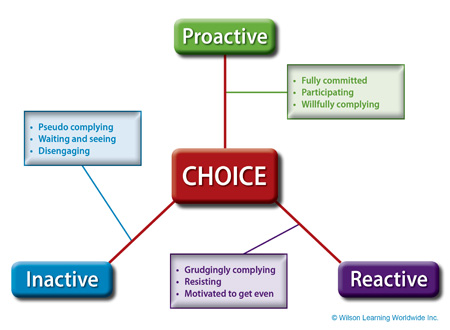Engagement Starts with Your Leaders
Create a Culture of High Energy and Commitment Through the 4 Levels of Leadership

Today, most organizations experience change that comes too often and too fast, and growth that comes too slow. As a leader, you are working hard to ensure you communicate exciting strategies to propel the organization forward in the context of opportunity and growth.
The dilemma for many of you as leaders is that your employees have been through—and continue to go through—so much change and upheaval that they are questioning whether they have the energy to engage in helping to drive the organization forward. To be successful, it's imperative that leaders create a culture of new energy and excitement—engagement—within the organization.
WHAT IS THE LEADER'S ROLE?
When focusing on engagement, it's important to understand who in the organization is really ready and who may need some help moving forward. During times like these, a certain pattern of behavior sets into many organizations. Generally, the leaders creating strategy are living in the future, concentrated on trends six months out. They are looking at the next quarter's time frame. Workers primarily function in the present, concentrated on accomplishing the key tactics of the day-to-day. Many workers find it difficult to shift into the mindset of future strategy and need time to process.
As a leader, it is your job to educate the entire organization, from top down, clearly identifying the path ahead. The challenge is to continue to move forward, with your employees feeling more than just clear and confident about the strategy and direction, but also excited and invigorated about the potential. As a leader in today's business environment, you are in the energy business—the human energy business. You are called to build a sense of engagement, helping employees realize the growth potential for the organization, the team, and themselves.
It's important to understand what we mean by engagement. Energy, not time, is the currency of engagement. Engagement is the combination of the perception of changes and events happening around you, and the level of energy experienced. So, highly engaged people have a positive perception of changes going on around them and they put a high level of energy into their work and everything else they do.
THE CHOICE MODEL

The purpose of a leader is to engage others in committing their full energy to the creation of value and success. But no matter how strong a leader you are, you cannot change people; they have to make the choice to change. Wilson Learning has created a model to illustrate how choice works. When it comes to choice, there are three states of decision: proactive, reactive, and inactive. People go through a process to get to a decision, moving around the model for different reasons at different points in their lives and careers.
When people are fully committed, participating in activities and willingly complying with organizational decisions set in motion, they are in the proactive state. They take ownership of what they do and how they do it. When people are resistant to change, grudgingly complying and perhaps motivated to "get even," they are in a reactive state. These people can act as deterrents to an organization's growth and progress. Those who step back to wait and see, pretend to comply, or disengage entirely, are in the inactive state. This also can have harmful effects on advancing your strategy.
As a leader, it is critical that you understand the concept of the Choice Model; then you can assess where employees are and help them to proactively commit their energy to the organization and themselves.
THE EMPLOYEE'S ROLE
Remember, you cannot engage people. People choose to be engaged or not. Your role is to create the conditions in which they choose to be engaged. With a little bit of your help, it might not be so difficult for them. Before you can really help, it's important to understand your employees' perspective in a situation of great change. Many studies focus on why people leave; more important is why they choose to stay and engage. Here are some questions your employees may be asking themselves as they decide to engage:
- Why should I get excited about work?
- What do my leaders and mentors expect?
- Am I in a culture that cares about me?
- How will I know how I am doing?
- How do I work effectively with others?
- Is leadership providing a good role model and positive example?
By placing yourself in your employees' shoes, you are better prepared to help them move toward being committed and engaged. But beyond just empathizing with employees, there is some work for you to do on your own. Strong leaders experience their own individual effectiveness through the Four Levels of Leadership.
THE FOUR LEVELS OF LEADERSHIP
How can you be successful in leading an engaged organization? Leaders today, like employees, need to work through their own Choice Model and be proactive in not only deciding to engage, but also in deciding to lead the organization toward a culture of engagement. An organization's culture is created from a set of shared beliefs, practices, customs, and behaviors. By working through the Four Levels of Leadership, you can begin the process of increasing your own leadership effectiveness and create a culture that works best for your organization.
- Leading Oneself—It all starts with you. You need to lead yourself before you can lead others. It's about being clear on your own sense of purpose and why you chose to be a leader. As with the old adage—"If you don't stand for something, you will fall for anything"—you also must have a clear sense of your values as a leader. These values guide you through decision making and other actions you take. You also must know and understand your own leadership strengths.
- Leading Others: One-to-One—The skills you use to facilitate the individual growth of others are often regarded as foundational, like communication skills, goal setting, and delegating. You need to have these basic critical skills to effectively lead individuals.
- Leading Teams: One-to-Group—In addition to one-to-one skills, leaders need to lead and inspire individuals to work effectively together and achieve results as a team. As organizations have flattened by removing the middle management layer and leaders' span of direct reports has increased, leading one-to-one is no longer efficient. Most leaders don’t have the luxury of spending time on an individual basis and must move toward leading on a one-to-group level. With the increase in virtual teams that act on a global basis with multiple complex relationships, the skills of leading one-to-group are multifaceted and include problem solving, leading meetings, facilitating dialogue, and managing conflict.
- Leading a Work Culture—The act of leading a work culture is distinct from the other levels. Many leaders focus on improving their one-to-one and one-to-group skills. However, today's leader needs to understand what it takes to create a culture that enables the full engagement of all employees. Leading a work culture is about leaders understanding their responsibility to engage others to commit energy to the organization.
A real opportunity exists for organizations to increase employee engagement and build a culture of engagement when leaders build their strength through the Four Levels of Leadership.
To get started, here are three steps you can take today to become the leader you want to be:
- Demonstrate a clear commitment to your own leadership purpose and values.
- Be a positive role model for the beliefs, practices, customs, and behaviors you want all employees to exhibit in their interactions with one another and in their day-to-day work.
- Encourage all employees to understand and share those same beliefs and behaviors, and coach to them.
The culture of the organization will happen whether you influence it or not. And as you move your organization through these new, exciting times, are you willing to run the risk that your employees' behavior is less than or not what you need it to be? Are your leaders actively involved in establishing a culture of engagement? If not, they need to be, with you setting the example.
At Wilson Learning, we believe that you become a successful leader by taking these steps to proactively sustain the new strategies and direction of a stronger company with a culture of engagement.
To learn more, contact Wilson Learning at 1.800.328.7937 or complete the online form.







 Please complete this form to download Engagement Starts with Your Leaders | Create a Culture of High Energy and Commitment Through the 4 Levels of Leadership.
Please complete this form to download Engagement Starts with Your Leaders | Create a Culture of High Energy and Commitment Through the 4 Levels of Leadership.



